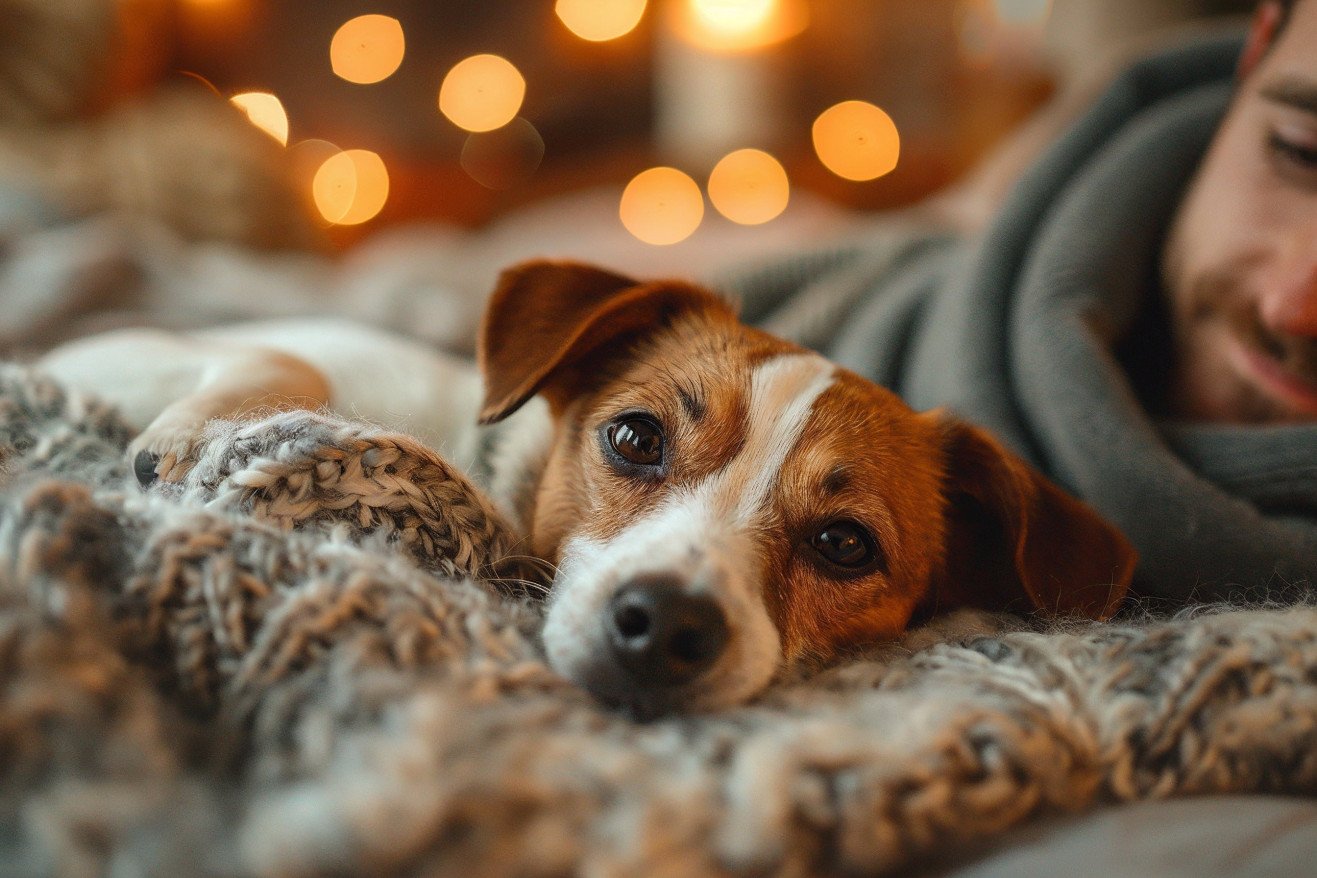Why Does My Dog Lay on Top of Me? Exploring This Cozy Behavior
27 April 2024 • Updated 27 April 2024

If you have a dog, you may be familiar with the experience of your pet wanting to snuggle up and lay on top of you. While it can be cute and funny, the behavior is often referred to as "dog dominance" and is a result of the pack mentality that dogs have. In a pack, dogs will physically claim space and resources to show their dominance, and in this case, they're claiming you! It's a way to show affection, but it's also a way for your dog to show that you are part of the same "pack".
While this adorable behavior is based in instinct, there are also psychological and physiological reasons that your dog may want to lay on top of you. To better understand why your dog wants to snuggle up and lay on top of you, we referenced animal behaviorists, evolutionary biologists, and veterinarians to get their take on the topic. By learning more about the science behind this behavior, you can better understand your dog and the long history of the human-canine bond.
Why does my dog lay on top of me?
What Does It Mean When Your Dog Wants to Cuddle?
When your dog snuggles up to you or lies on top of you, they are using body language to communicate. By understanding what your dog is trying to say, you can better understand their motivations and what they may be feeling when they want to cuddle.
According to the American Kennel Club, a happy, relaxed dog will have a relaxed, open mouth with a lolling tongue and a tail that wags softly. This is a sign that your dog feels comfortable and secure enough to snuggle with you. However, excessive licking, yawning, or fidgeting can be a sign of anxiety or a call for your attention.
More worrisome is growling, stiffening, or guarding behavior when your dog is lying on you, which can indicate resource guarding or dominance, according to PawSafe. It is important to pay attention to your dog’s body language as a whole in the moment, not just one sign, to understand what they are trying to tell you.
If your dog is cuddling with you in a relaxed way, it can be a great way to strengthen your bond. However, if you are aware of signs of anxiety or aggression, you can address any potential problems, ensuring that your dog’s desire to cuddle remains a positive experience for both of you. This sets the stage for understanding how different breeds may have different levels of physical affection.
The Breed Factor: Velcro Dogs and Their Love of Cuddles
Some dog breeds are more affectionate and more likely to seek out physical contact with their humans than others. For example, Bulldogs, Labradors, Golden Retrievers, and Cavalier King Charles Spaniels are all considered 'velcro dogs' because of their love of cuddling, according to Southern Living. This is because these breeds were originally bred to be companions, which has led to their people-pleasing personalities and their love of physical contact.
That said, a dog's personality is also influenced by their genetics, and any breed can be more or less affectionate or independent based on their genetics and their socialization, according to PetMD. A dog's early life experiences, training, and relationship with their owner also have a big impact on how much they like to cuddle. As Newsweek explains, "If you take a very young puppy, them choosing whether they want to sleep with a human depends on their early learning experiences and their level of confidence."
Setting Boundaries: When Dog Cuddling Goes Too Far
While cuddling is a natural behavior for dogs, it can become problematic if it happens too much or in the wrong situations. Laying on owners too much can be a sign of separation anxiety, resource guarding, or a lack of training and boundaries. To avoid these problems, it's important to train dogs to do something else, like lie down on a bed or mat, as suggested by the American Kennel Club.
Making sure dogs get enough exercise, mental stimulation, and not accidentally rewarding the behavior can also help prevent too much cuddling, according to AKC expert advice. In some cases, it may be necessary to work with a professional dog trainer or behaviorist to get to the bottom of the issues that are causing the behavior. By setting boundaries, you can make sure your dog's cuddly behavior is a positive experience for both of you. This will lead us to the next section, where we'll talk about the potential drawbacks and benefits of letting your dog sleep in your bed.
The Pros and Cons of Co-Sleeping: Exploring the Risks and Benefits
Co-sleeping is a common practice among dog owners. In fact, the American Kennel Club reports that studies have found that just under half of all dog owners let their dogs sleep in their bed or bedroom. Co-sleeping can lead to increased comfort, companionship, and a greater sense of security for both the dog and the owner, according to Healthline.
On the other hand, co-sleeping comes with a number of potential downsides, including sleep disruption, increased exposure to allergens and infectious diseases, and the possibility of injury, especially for children. Everyday Health explains that co-sleeping can lead to more frequent awakenings during the night, and aggressive behavior from dogs can lead to disruptions and even injuries. To help reduce these risks, the Sleep Foundation recommends that people who co-sleep with their dogs make sure to practice good hygiene, set clear boundaries, and make sure their dog is well-trained and well-behaved.
In the end, whether or not to co-sleep with a dog is a decision that should be based on an individual's needs and preferences, and that takes into account the potential risks and benefits of the practice. By considering these factors, dog owners can make a decision that helps them build an even stronger relationship with their four-legged friends.
Building the Human-Dog Relationship: Cuddling as a Way to Bond
Cuddling and physical contact with their humans can also be a way for dogs to bond with their families. Dogs have learned to associate their humans with feelings of safety, security, and love, and cuddling can help to reinforce these positive feelings, says Wild Earth. In addition, humans can use cuddling to engage in positive reinforcement training, which can help to build trust and a stronger bond with their dogs, according to K9 Basics.
That said, it's important to remember to respect your dog's personal space and not to force them to cuddle if they don't want to, especially if they're showing signs of stress or anxiety, says PureWow. When done with patience, consistency, and respect, cuddling can be a positive experience that strengthens the special relationship between dogs and their humans. This, in turn, can help us to better appreciate the lovable quirks of our four-legged friends.
Conclusion: Embracing the Cuddly Canine Companion
Dogs' desire to lay on or cuddle with their owners is a normal behavior that is rooted in their pack mentality and their need for security and affection. While this behavior can be endearing, it's important to understand the underlying motivations and establish healthy boundaries if it becomes excessive. A dog's breed, personality, and the strength of their bond with their owner can all influence their cuddling behavior.
With patience, training, and mutual respect, cuddling can be a rewarding experience that strengthens the unique bond between dogs and their human families. By understanding and embracing this cozy behavior, we can deepen our appreciation for the special relationship we share with our canine companions.


